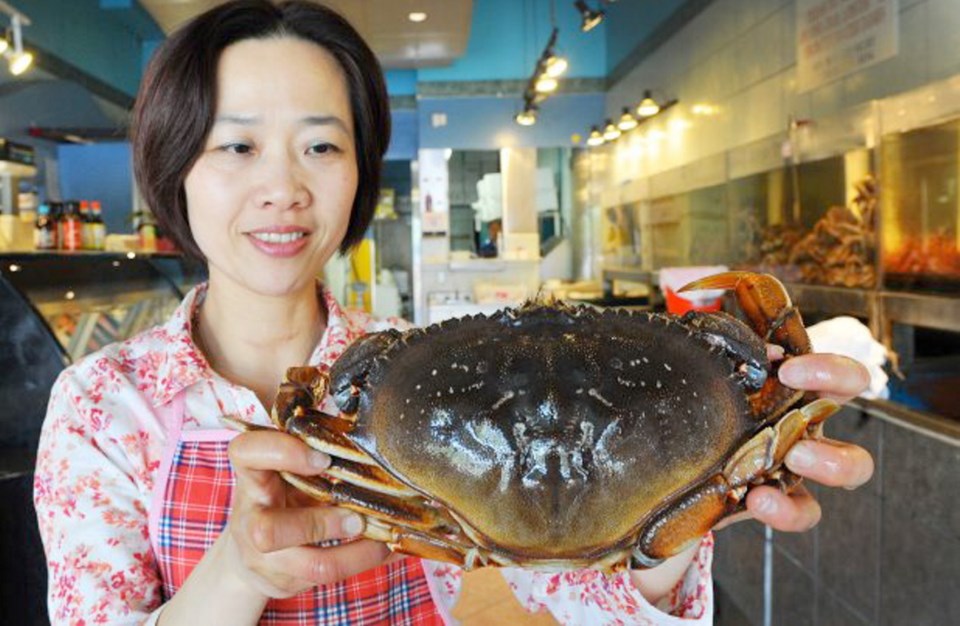A poor commercial catch and steady demand from Asia are pushing prices for local Dungeness crab so high that some shops no longer carry them.
Others have given up trying to make money on the crab and are selling it just to break even.
“In 18 years we’ve been in business, we’ve never seen it so crazy,” said Jimmy Chiong, owner of the Oakridge Fish Market at Oakridge Centre Mall.
He is charging customers $16 per pound for live crab, but that’s a bargain as he is only looking to break even from the product, which is now selling for more than double what markets would have charged a year ago.
Right now, Chiong is just trying to “keep customers happy.”
At Seafood City on Granville Island, they are selling the Dungeness crab for $20.90 a pound, compared to the $10.90 they would have charged a year ago.
“It’s kind of sad not to be able to offer it to our customers (cheaper than) $50 a crab,” said salesman Zach Kuefeler-Mevin.
Lili Andrade, retail manager for 7 Seas Fish Co. Ltd., said the company stopped carrying Dungeness crab at the company’s two stores in Kitsilano and South Surrey because she would have to charge $21.95 a pound, which is a dollar more than the live Atlantic lobster they carry.
“Its market value (is) always going up and down,” Andrade said. “At this time, those are the prices.”
And it isn’t just Dungeness crab that has seen high prices this year. Guy Dean, vice-president of local wholesaler Albion Fisheries Ltd. said prawns are also selling this year at prices 35 to 40 per cent higher than a year ago because of a disease that has affected farm-raised product in Asia.
And Dean added that halibut, which is now retailing at prices ranging from $23 to $30 per pound for clean fillets at Lower Mainland markets, is being held high by big reductions in quotas for commercial fisheries up and down the coast.
“Pricing is such that it’s become more of a premium white-tablecloth (product),” Dean said.
But it is the price for local Dungeness crab has been particularly noticeable over the past few weeks.
“It’s not a good year for fishing, and demand is so high based on that,” said Mike Green, key account manager for 7 Seas’ wholesale operation. “(And that) has pushed everything to these high prices.”
Green said the market is so tight that some of the regular fishermen who supply the company are capping their sales to 7 Seas at 10 to 20 pounds of live crab per day. “In previous years, we could almost ask for whatever we needed, weight-wise.”
The commercial crab catch in B.C., which is mostly Dungeness, has varied widely in previous years. The catch for 2012 was 3,500 tonnes, compared with 3,400 tonnes in 2011 and 5,200 tonnes in 2010, according to figures reported by the B.C. Ministry of Agriculture.
And while provincial publications don’t report exports by volume, their value has increased in recent years, hitting $90 million in 2013 compared with $72.3 million in 2012 and $57.3 million in 2011. China, the U.S. and Hong Kong are the top markets for B.C. crab.
Ministry of Agriculture publications don’t break down crab exports by market, but China is the second-biggest buyer of all B.C. seafood, accounting for 14 per cent of sales worth $121 million in 2012, mostly in shellfish.
The demand is noticeable among B.C. wholesalers, and Green said that so far in 2014, Asian markets “are willing to pay the prices.”
However, the high prices have begun to crimp demand in China, said exporter Claude Tchao, CEO of Tri-Star Seafood Supply Ltd. He said the company has stopped trying to compete.
Tchao said Dungeness crab is prized in China, where it goes by names such as “gold crab” or “jumbo crab”, but at the prices he has to pay to get it ($18 per pound at the peak), it is only some restaurants in Shanghai that will buy.
He added that a major national holiday in China that drove demand for fresh crab in recent weeks has just concluded, and he anticipates that demand will now fall, along with prices.
“I cannot sell one piece to Beijing or Guangzhou (markets),” Tchao said of the current prices, and “only maybe 10 per cent of the volume can go to Shanghai right now. Is that a healthy market?”
He added that it isn’t just China that is driving demand for Dungeness crab. It has become popular in Taiwan, Hong Kong and Singapore as well, besides being a staple in North America.
Tchao said Tri-Star has good suppliers, but suspects some fishermen have been playing the local market’s 20 to 25 exporters off against each other to bid prices up.
“We’ve set a reasonable price we think we can make a little money at,” said Tchao. “If (fishermen) want to come, you come.”
This year’s crab season started with a poor harvest in Washington State, which has a much bigger fishery than B.C.’s, and is typically a bigger supplier to the North American market, he said.
Rich Childers, the manager of Puget Sound’s shellfish fishery for Washington State Department Fish and Wildlife, confirmed that the early season “was kind of a bust” before it closed at the end of March resulting in record prices of $9 US per pound for landed Dungeness.
Tchao added that he expects more local crab will be available by the end of June as more areas open to fishing.



